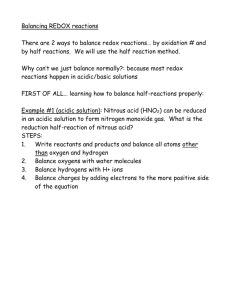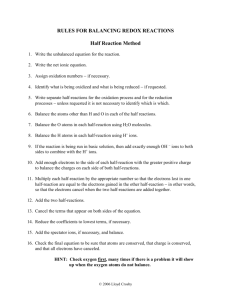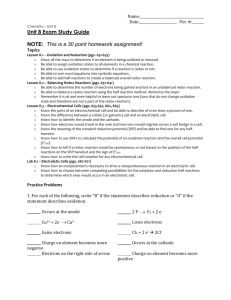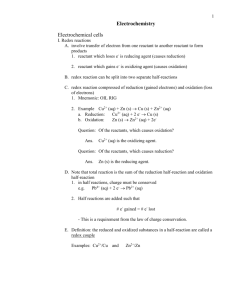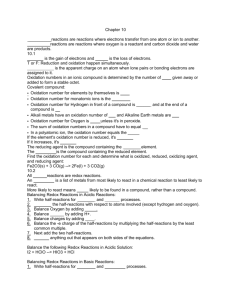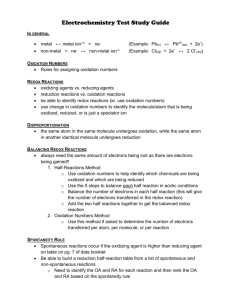Unit 5 Notes
advertisement
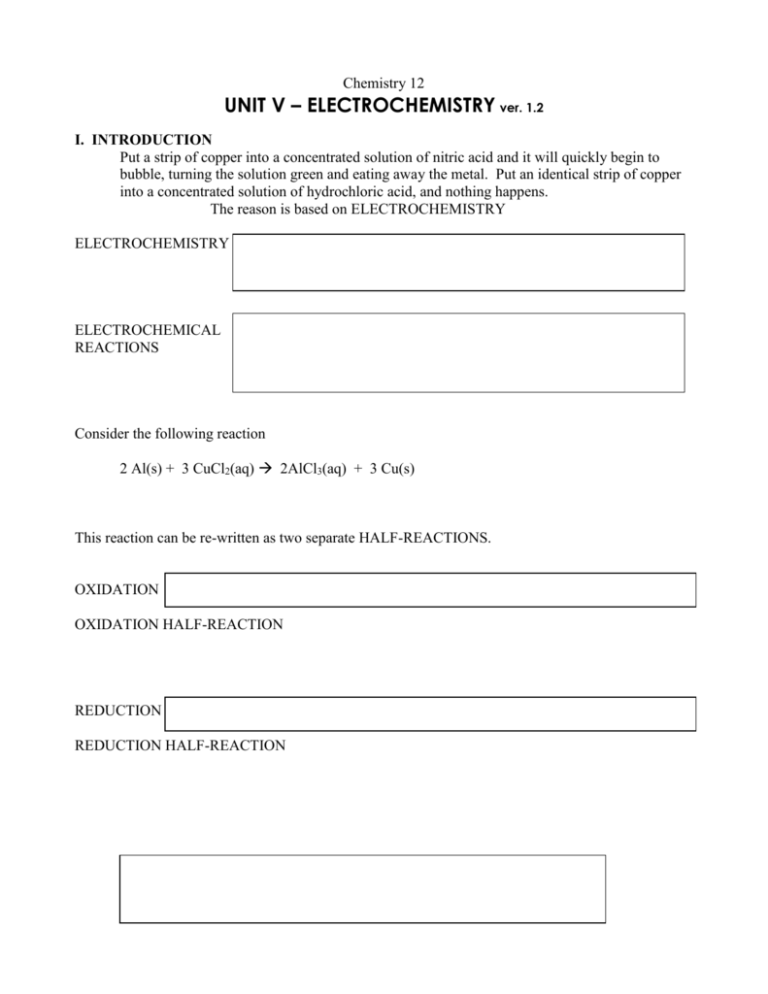
Chemistry 12 UNIT V – ELECTROCHEMISTRY ver. 1.2 I. INTRODUCTION Put a strip of copper into a concentrated solution of nitric acid and it will quickly begin to bubble, turning the solution green and eating away the metal. Put an identical strip of copper into a concentrated solution of hydrochloric acid, and nothing happens. The reason is based on ELECTROCHEMISTRY ELECTROCHEMISTRY ELECTROCHEMICAL REACTIONS Consider the following reaction 2 Al(s) + 3 CuCl2(aq) 2AlCl3(aq) + 3 Cu(s) This reaction can be re-written as two separate HALF-REACTIONS. OXIDATION OXIDATION HALF-REACTION REDUCTION REDUCTION HALF-REACTION -2When a substance becomes OXIDIZED: Ex. When a substance becomes REDUCED: Ex. REDUCTION-OXIDATION REACTION Ex. Consider the following reaction: 2 Al + 3 Cu2+ 2 Al3+ + 3 Cu Al: Cu2+: ANY TIME THAT YOU SEE THAT AN ATOM OR ION HAS CHANGED ITS CHARGE DURING A REACTION, YOU ARE DEALING WITH A REDOX REACTION. -3Ex. Are the following atoms being oxidized or reduced (and would that make them the oxidizing agent or the reducing agent?) a. I- I3+ + 4eb. Au3+ + 3e- Au c. Cu+ Cu2+ + ed. F2 + 2e- 2F- Ex. For the following reactions indicate which substance is: a. being oxidized, b. being reduced, c. the oxidizing agent, d. the reducing agent. Zn2+ + Mg Zn + Mg2+ 2 Na + Br2 2 Na+ + 2 Br- II. OXIDATION NUMBERS OXIDATION NUMBER You will need to be able to calculate the oxidation numbers of various atoms. RULES FOR DETERMINING OXIDATION NUMBER 1. 2. i. -4ii. iii. 3. 4. 5. 6. Ex. Determine the oxidation number of each atom for the following: a. Na c. N2O4 b. CCl4 d. PO43- Try: Determine the oxidation number of each atom for the following: a. P4 c. H4P2O7 b. PbSO4 d. NH4+ An atoms change in oxidation number indicates if it is being reduced or oxidized. -5Consider the following ClO3- ClO4H2O2 H2O Cr3+ CrO42NO2 N2O3 III. PREDICTING THE SPONTANEITY OF A REDOX REACTION There is a table called the Table of Standard Reduction Potentials, which is partially shown below. F2 + 2 e- ↔ 2 FAg+ + e- ↔ Ag Cu2+ + 2 e- ↔ Cu Zn2+ + 2 e- ↔ Zn Li+ + e- ↔ Li The following observations can be made from the Table of Standard Reduction Potentials. (These will help you locate a half-reaction much more quickly) 1. 2. 3. -6Ex. 4. The Table of Standard Reduction Potentials is used in a similar way to the Table of Relative Strengths of Acids and Bases. Ex. The half reaction for Zn and Zn2+ is: If there was a piece of Zn(s) in a solution of Zn2+(aq) you can write either: Note – When referring to an ISOLATED half-reaction, use equilibrium arrows to show that the reaction can go forward or backwards. If the half-reaction is made to UNDERGO EITHER REDUCTION OR OXIDATION AS A RESULT OF BEING PART OF A REDOX REACTION, then use a one-way reaction arrow. -7Try: State if the following ions could undergo reduction, oxidation, or both: a. Ni2+ c. NO e. Fe2+ b. Cl- d. Cu+ f. Al3+ Become familiar with the idea that reduction equations are those on the table in the forward direction and oxidation equations are those in the reverse direction. Assume you have two different half-reactions in two different beakers. In one beaker there is Zn(s) in a solution of Zn2+, and in the other is Cu(s) in a solution of Cu2+. The two possible half-reactions are: Of the two oxidizing agents _____ and _____ , the ______ is higher on the left side of the table, and therefore has a greater tendency to become reduced. The reduction reaction will be: Of the two reducing agents _____ and _____ , the _____ is lower on the right side of the table, and therefore has a greater tendency to be oxidized. The oxidation reaction will be: Recall: The overall reaction, which in this particular case will occur spontaneously, is found by adding together the two half reactions – ONE OXIDATION AND ONE REDUCTION. -8- Try: Which is the stronger oxidizing agent in each of the following pairs: a. Ag+ or Cu2+ b. Co2+ or Au3+ Try: Which is the stronger reducing agent in each of the following pairs: a. H2O or H2O2 b. Sn2+ or Cu+ Ex. If you are only given two species (or ions) rather than the four needed for two complete half-reactions as given above, you will need to be able to predict if that particular redox reaction will occur. RULES FOR PREDICTING SPONTANEOUS REDOX REACTIONS 1. If only one species in a half reaction is present, don’t assume that the other species is also present. You need to be explicitly told if the other species is present. Ex. 2. If you are only given two potential reactants, rather than complete half-reactions, a reaction may or may not occur. In order to determine if a reaction will occur, the first thing to do is: -9There are three possibilities: A. Ex. Assume the only reactants are Zn and Cu. Ex. Assume the only reactants are Br- and Cl-. B. If one is on the left of the table and one is on the right of the table two different cases are possible: i. Ex. Assume the reactants in a vessel are Cu2+ and Zn. ii. Ex. Assume the reactants are Zn2+ and Cu. -10+ Try: Which of the following species will oxidize Cu ? Ni2+ Ag+ Pb2+ I2 H2O Try: Predict whether or not a reaction will occur when the following are mixed: a. Cl2 and Br- b. Sn and Mn c. Ni2+ and Pb d. Cl2 and K COMMENT ON H+ Some half-reactions require H+ to occur. Ex. If H+ is present in a particular half-reaction, it must be treated like any other reactant. For example, if you are asked whether the SO42- in a solution of Na2SO4 will reduce: Your answer should be ‘there is no reaction unless H+ is could is present also” (or likewise “only if the solution is acidic”), just as nothing would happen if SO42- wasn’t present – same with H+. There will be no reaction if it were not present. -11IV. BALANCING HALF-REACTIONS A half-reaction must be balanced, just as other chemical reactions must be balanced, however halfreactions are balanced for mass and CHARGE. Balancing half-reactions is not overly complicated, but it is very easy to make mistakes if you are careless about writing the charges on ions. BALANCING HALF-REACTION STEPS Usually when you are required to balance a half-reaction, you will be given a ‘skeleton equation’ containing the major atoms. It is up to you to complete the balancing by applying other species as follows: 1. 2. 3. 4. Note – NEVER vary the order of balancing, it will make it difficult to impossible if you don’t follow the above order EXACTLY. Memory aid: -12Ex. Balance the half-reaction: Ex. Balance the half-reaction: RuO2 ↔ Ru Cr2O72- ↔ Cr3+ Try: Balance the half-reaction: MnO4- ↔ Mn2+ BALANCING BASIC HALF-REACTIONS All the above solutions were assumed to be in acidic solutions. Sometimes you will be required to balance half-reactions in BASIC conditions. First, balance as if it were in acidic conditions Ex. Pb ↔ HPbO21. Balance the major atoms 2. Balance the oxygen atoms 3. Balance the hydrogen atoms 4. Balance the charge. -13Now, CONVERT THE EQUATION TO BASIC CONDITIONS which is done by: 5. Adding the water equilibrium equation in such a way as to CANCEL OUT ALL THE H+ in the half reaction. Try: Balance the following: a. HC2H3O2 ↔ C2H5OH in acidic conditions b. MnO4- ↔ MnO2 in basic conditions V. BALANCING REDOX EQUATIONS USING HALF-REACTIONS Note: There are two common methods for balancing redox equations: using half reaction and using oxidation numbers. You are not required to know both methods (as they end up with the same results) but it may be to your advantage to be familiar with both of them. Balancing using half-reactions is easier for more complicated redox equations, the oxidation number is easier for simpler redox equations. STEPS IN BALANCING EQUATIONS USING HALF REACTIONS Ex. Balance ClO4- + I2 Cl- + IO3- in acidic solution. 1. -14- 2. 3. 4. Try: Balance MnO4- + C2O42- MnO2 + CO2 in basic solution. -15DISPROPORTIONATION REACTION Ex. Balance ClO2- ClO3- + Cl- in basic solution. STEPS IN BALANCING REDOX EQUATIONS USING OXIDATION NUMBERS This method is somewhat of a shortcut, based on that fact that since the total number of electrons lost in an oxidation half-reaction must equal the total number of electrons gained in a reduction halfreaction, so the following two statements are true: Ex. Balance the following redox reaction 1. 2. ClO4- + I2 Cl- + IO3- -163. 4. Ex. Balance P4 H2PO2- + PH3 in acidic solution Try: Balance Zn + As2O3 AsH3 + Zn2+ in basic solution. -17Try: Balance S 2- + ClO3 Cl + S (basic) - - Try: Balance CN- + IO3- I- + CNO- (acidic) Try: Balance As4 + NaOCl + H2O AsO43- + NaCl VI. REDOX TITRATIONS Acid-base titrations are very useful as they allow an accurate determination of an unknown concentration of an acid or a base. In a similar manner, there are many occasions where you may need to know the concentration of a substance that is capable of undergoing an oxidation or reduction reaction. A. OXIDIZING AGENTS One of the most useful oxidizing agents that you will encounter is _______________ . The half reaction: -18It has such a strong tendency to reduce (note its position on the table - _____________________) that it is able to oxidize a large number of substances (the K+ in KMnO4 is left out as it is a spectator ion). Ex. To find the [Fe2+] in an unknown solution, react it with acidic MnO4- as follows: Recall that acid base titrations use an indicator to help see the equivalence point of the titration. The above redox titration also requires some way to identify the equivalence point. Another reason the KMnO4 is so commonly used in redox titrations is that: Ex. A 100.0 mL sample containing FeCl2 is titrated with 0.100 M KMnO4 solution. If 29.15 mL of KMnO4 was required to reach the endpoint, what was the [Fe2+]? B. REDUCING AGENTS Two commonly used reducing agents are ______ and _______ . A large number of substances can oxidize I- to I2 (as it is relatively low – about halfway down the table) according to the following halfreaction: Titrations involving I- generally involve two consecutive steps: 1. 2. -19- An example of a reaction involving I is the reduction of laundry bleach, NaOCl. The reaction between I- and OCl- proceeds as follows: No attempt is made to add exactly enough I- to react with the OCl-. Rather: The above reaction between OCl- and I- is the ‘initial’ reaction because the actual redox titration involves a second reaction between the I2 produced, and another ion present in the titrating substance, the reducing agent sodium thiosulphate, Na2S2O3. When the addition of S2O32- has reacted most of the I2 present, the brown colour of the I2 almost disappears (a diluted colour appearing pale yellow remains). Some starch solution is then added to the titration, which produces a dark blue colour (this is caused by the reaction between starch and the remaining I2 in solution). After adding the starch (which acts as a more noticeable and therefore more precise indicator), the last of the S2O32- is added, causing the blue colour of the starch-I2 mixture to fade – so that the last of the colour just disappears at the equivalence point between the I2 and the S2O32-. Ex. A 25.00 mL sample of bleach is reacted with excess KI according to the following equation: 2 H+ + OCl- + 2 I- Cl- + H2O + I2 The I2 produced requires exactly 46.84 mL of 0.7500 M Na2SO3 to bring the titration to the endpoint using starch solution as an indicator, according to the following equation: 2 S2O32- + I2 S4O62- + 2 IWhat is the [OCl-] in the bleach? -20- VII. ELECTROCHEMICAL CELLS Recall the half-reactions need to be somehow connected in order for both reactions to occur (a donating and accepting of electrons needs to occur). ELECTROCHEMICAL CELL Consider the reaction: A spontaneous reaction will occur when zinc metal is placed into a solution of CuSO4. However, The exact same reaction can be used to produce electricity if: ELECTRODE ANODE -21CATHODE Memory aid: ELECTROCHEMICAL CELL DIAGRAM 1.The possible half-reactions are: 2. After the half-cells are connected: 3. As electrons are supplied to the Ag electrode: -224. Overall, the electron flow is: 5. The salt bridge: 6.As Cu2+ ions are formed: 7.As the [Ag+] is depleted around the cathode: -23Ex. Assume two half-cells consisting of Pb(s) in a Pb(NO3)2 solution and Zn(s) in a ZnCl2 solution are connected to make an electrochemical cell. Draw and label the parts of the cell, write the equations for the individual half reaction and overall reaction, and indicate the direction in which the ions and electrons move. -24VIII. STANDARD REDUCTION POTENTIALS VOLTAGE Since electrons cannot flow in an isolated half-cell, the voltage of an individual half-cell cannot be determined. However: A ZERO-POINT is arbitrarily defined on the voltage scale. Specifically the voltage for the HYDROGEN HALF-CELL: An electrochemical cell is said to be at STANDARD STATE if: All voltages listed in the table of STANDARD REDUCTION POTENTIALS are determined at standard state and are compared to the standard reduction potential of the hydrogen half-cell. Ex. Cu2+ + 2e- ↔ Cu ……… Eo = + 0.34 Ex. Zn2+ + 2e- ↔ Zn ……… Eo= -0.76 -25Since the voltage is a measure of work done (so work in either done or is being done), reversing a reduction reaction such as Zn2+ + 2e- ↔ Zn ……… Eo= -0.76 produces: When two half reactions are combined, Ex. Ex. Calculate the potential of the cell Ni2+ + Fe Ni + Fe2+ -26- Ex. Calculate the potential of the cell: Mn + Mg2+ Mn2+ + Mg Ex. Calculate the potential of the cell: 3 Ag+ + Al 3Ag + Al3+ Try: Calculate the potential for the cell and state if it would be expected to be spontaneous: 2 H2O2 2 H2O + O2 Although Eo can be used to predict if a reaction is spontaneous, it has no correlation to the rate of the reaction. Recall that the ___________________________ of a reaction determines the rate at which it will proceed. -27COMMENT ON WATER If a reaction occurs in a neutral solution, the reduction of neutral water (at – 0.41 V) may be a possible reaction and must be considered along with any other reductions possible. If a reaction occurs in an acidic solution, the reduction of H+ (at 0.00 V) may be a possible reaction and must also be considered along with any other reductions possible. (you won’t be asked to deal with basic solutions) SURFACE AREA OF ELECTRODES HALF-REACTIONS NOT AT STANDARD STATE If a half-cell is not at standard conditions, there will be a change in the potential. Ex. -28According to Le Chatalier’s principle, if the [Cu ] is increased so it is > 1.0 M, the equilibrium will shift 2+ And if the [Cu2+] is decreased so it is < 1.0 M, the equilibrium will shift: Notice that the ‘o’ is dropped from the above equations as they are NOT at standard state. CELLS THAT REACH EQUILIBRIUM Operating chemical cells ARE NOT AT EQUILIBRIUM. The reaction arrow is in one direction. Ex. THE REDUCTION REACTION THE OXIDATION REACTION Overall, the following occurs as cell go towards equilibrium: INITALLY AS RXN PROCEEDS (TIME PASSES) EVENTUALLY -29- IX. SELECTING PREFERRED REACTIONS When a cell contains a mixture of substances, several different half-reactions (and therefore overall reactions) may appear to be possible. Consider the following cell: The species present are: WHEN SEVERAL DIFFERENT REDUCTION HALF-REACTIONS CAN OCCUR WHEN SEVERAL DIFFERENT OXIDATION HALF-REACTIONS CAN OCCUR -30Ex. A strip of iron metal is placed in a mixture of Br2(aq) and I2(aq). What is the preferred reaction that will occur? SPECTATOR IONS Any ion capable of being reduced will be a spectator ion if: Any ion capable of being oxidized will be a spectator ion if: Some ions are more commonly used in making electrochemical cells because they have such a low tendency to oxidize or reduce that they rarely come into play in a reaction. Common Spectator Ions: X.CORROSION OF METALS CORROSION When a drop of water rests on an iron surface, a spontaneous reaction occurs: At the oxygen-poor region in the center of the drop, the iron oxidizes. -31Once the Fe is formed, it tends to migrate away from the anode (random movement from higher to lower concentrations). As they move away, more Fe(s) is exposed underneath the drop. 2+ At the same time, the reaction: Is occurring at the oxygen-rich outer surface of the drop. When the Fe2+ reaches this region, it encounters the OH- and precipitates as Fe(OH)2(s). The Fe(OH)2 is eventually oxidized to a complex mixture of Fe2O3 and H2O by the O2 in the air. Rust is Fe2O3.XH2O where ‘X’ can change. Rust can have numerous different colours (red, brown, yellow, black) since differing numbers of water molecules attached to the iron(III) oxide will change the colour of the compound. A metal can corrode if it touches a different type of metal in the presence of an electrolyte solution exposed to oxygen. For example, if iron touches copper wire and the spot where they touch gets wet, then: The copper conducts the electrons away from the Fe and makes them available to the oxygen/water touching the wire. PREVENTING CORROSION There are several ways to stop or at least slow down corrosion, all of which fall into two main categories. 1. ISOLATING THE METAL FROM ITS ENVIRONMENT a. b. 2. ELECTROCHEMICAL METHODS a. Cathodic protection -32Ex. Both Mg and Zn are ________________________ than iron, so if pieces of magnesium or zinc are attached to the surface of iron, the Mg or Zn will: Ex. Strips of zinc are often bolted to the iron-hull of ships below the water line. The zinc is ‘sacrificed’ (and eventually needs to be replaced) to keep the iron of the ship from oxidizing and corroding. Some ships even pass a low voltage electric current into the hull from an electric generator. This forces electrons into the metal and prevents it from being oxidized. Ex. Galvanized iron simply has a zinc coating. The zinc reacts preferentially with air and water, forming a zinc oxide layer which protects the iron as it adheres strongly and prevents the exposure of the underlying metal to air and water. Ex. Some buried gas and oil tanks made of steel have a thick braided wire connected to them. The wire comes to the surface and is attached to a post in the ground that is made of an easily oxidized metal such as magnesium or zinc. Because the post will oxidize first, the buried tank is protected. b. Change the conditions of the surroundings When iron is placed in contact with water containing oxygen, the following halfreaction will oxidize the iron: If oxygen is removed from the system, the tendency for it to reduce is drastically reduced. (Hydrogen will be reduced first as it is higher on the table). Another method is to lower the [H+] ions by adding OH- ions. A piece of iron will not rust (or a very little amount until all the oxygen has reacted) in a basic solution. XI. ELECTROLYSIS ELECTROLYSIS -33ELECTROLYSIS OF A MOLTEN BINARY SALT BINARY SALT When such a salt is melted, the ions are free to move in the liquid form (molten NaCl is NaCl(l), as only Na+ and Cl- ions are present. Do not confuse it with NaCl(aq) which is a solution containing Na+, Cl-, and H2O.) Also note that there is no need for a salt bridge to keep the reactant separated as no spontaneous reaction will occur between the reactants. The only reactants present are Na+ and Cl- The anode reaction is: The cathode reaction is: The overall reaction is: In order for the above cell to operate: Since the half cells are not at standard state, the reduction potentials will be different than those listed on the table. -34ELECTROLYSIS OF AN AQUEOUS SOLUTION Consider the electrolysis of aqueous sodium iodide, NaI(aq). This involves another consideration – now water is also present in the system. Inert electrodes are used and the cell is set up as follows: There are two possible reducing agents: There are two possible oxidizing agents: So, in order to determine which reaction will occur, think back to the definition of electrolysis – electrical energy is applied to produce a chemical change. It makes sense that the reaction that: Looking at the above example. The preferred reaction (requiring the least voltage input) involves the higher of the two possible reductions (strongest oxidizing agent) and the lower of the two possible oxidations (strongest reducing agent). The same situation applies to electrolysis as did for spontaneous reactions: -35The half-reactions and overall reaction for the electrolysis of NaI(aq) is: Note – The concentrations of the materials in cells in not relevant – as long as there is sufficient material in the cell you can assume that the reactions proceed as predicted. IN REALITY It is most often found that a higher potential than calculated must be applied to cause electrolysis. This is due to: The difference between actual potentials required for electrolysis and the calculated potentials are termed_________________________. As a result of the overpotential effect, when dilute neutral solutions ( <1.0 M) containing Cl- or Br- are electrolyzed: -36Oxidation: You would expect that O2 would be produced. In reality it is found that _____ or _____ are actually produced. When dilute solution of certain metals are electrolyzed: Reduction: You would expect that H2O is produced, but in practice _____________________ are produced. Ex. What products are formed at the anode and cathode and what is the overall reaction when a solution containing NiSO4(aq) is electrolyzed using inert electrodes? Determine the minimum voltage required. Ex. -37What is the overall reaction which occurs when a 1.0 M solution of HCl(aq) is electrolyzed using carbon electrodes? XII. ELECTROPLATING ELECTROPLATING The Cathode is: The Electroplating Solution is: The Anode is: You will only be asked about electroplating in NEUTRAL solutions. -38Ex. Design a cell to electroplate a copper medallion with nickel metal. Include in the design: a. the ions present in the solution b. the direction of ion flow c. the substance used for the anode and cathode d. the direction of electron flow when the cell is connected to a DC power source ELECTROREFINING At the anode the small amounts of Zn or Pb present is preferentially oxidized as it is exposed at the surface. When any exposed Pb/Zn atoms have oxidized and gone into solution as ions, only the Cu atoms are available to be oxidized. Any Au, Ag, or Pt atoms present cannot be oxidized because the anode is mostly copper which is oxidized in preference to Au, Ag, or Pt which simply drop off and accumulate on the bottom of the cell. This ‘anode sludge’ can be purified to obtain the valuable metals. -39XIII. APPLIED ELECTROCHEMISTRY A. THE BREATHALYSER When alcohol is consumed, it is absorbed into the blood stream from the stomach. Some of it passes through the cell walls of blood capillaries into the alveoli (air sacs that make up the lungs), in a similar manner that CO2(g) and O2(g) enter in and out of the lungs. The process of alcohol entering the bloodstream and entering the lungs is at equilibrium so that the greater the concentration of alcohol in the blood, the greater the concentration of alcohol in the lungs. When the lungs exhale, the ethanol in the lungs is expelled. Ethanol undergoes oxidation by an acidic solution of dichromate ions as follows: 3 C2H5OH + 2 K2Cr2O7 + 8 H2SO4 3 CH3COOH + 2 Cr2(SO4)3 + 2 K2SO4 + 11 H2O (Cr2O72- is orange/yellow) (Cr3+ is dark green) The expelled air is blown into a breathalyzer which can measure and record the amount of green colourization. The more green the more alcohol in the breath. The machine is calibrated to be able to accurately calculate the blood alcohol content. B. BATTERIES 1. The Lead-Acid Storage Battery A car battery is of this type, consists of alternating pairs of plates of Pb(s) and PbO2(s) immersed in dilute sulphuric acid. The anode reaction is: Pb(s) + HSO4-(aq) PbSO4(s) + H+(aq) + 2e- (or Pb Pb2+ + 2e-) The cathode reaction is: PbO2(s) + HSO4-(aq) +3H+ +2e- PbSO4(s) + 2H2O (or Pb4+ + 2e- Pb2+) The overall reaction (Pb + Pb4+ Pb2+ + Pb2+) occurs when the battery is discharging – spontaneously reacting to produce electrical energy. This forms an insoluble PbSO4(s) layer on the plates of the battery. When an external charge is applied, the reaction is driven backwards. (Over time the PbSO4 tends to flake off the plates so less Pb and PbO2 can be formed, so eventually the battery needs to be replaced.) -402. The alkaline battery Gets its name from the alkaline (basic) electrolyte (KOH) that is used. The cathode reaction: 2 MnO2(s) + H2O(l) +2e- Mn2O3(s) + 2 OH-(aq) The anode reaction: Zn(s) + 2OH-(aq) ZnO(s) + H2O(l) +2e- Cheap to make, but cannot be recharged (or reversed), has a relatively short shelf life (reaction continually occurs slowly whether the battery is being used or not).
